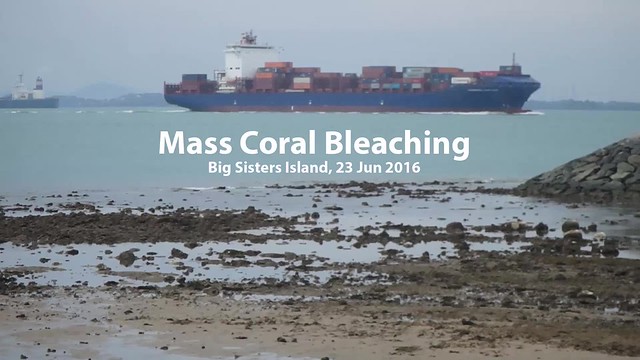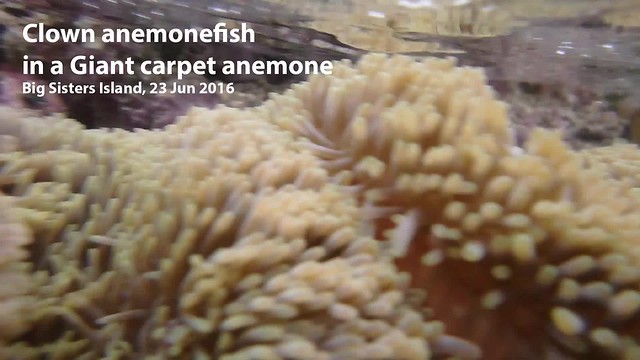The survey team asssess about 60% of the hard corals we saw were bleaching, 50% for leathery soft corals and 50% for sea anemones. Big Sister's Island has more corals in number and variety than Small Sister's Island.
The visibility is good today and we could see more bleaching right at the jetty.
Here's a video of the coral bleaching we saw at Big Sisters Island today.
Mass coral bleaching in Singapore is not unexpected. From the NOAA's coral reef watch satellite monitoring,Singapore is in the yellow Watch zone. Where we should be prepared for mass coral bleaching.
What is coral bleaching?
Coral are colonies of tiny animals called polyps. Each polyp lives inside a little hard skeleton. The huge colony is made up of the skeletons of countless polyps. The polyps of all reef-building hard corals harbour microscopic, single-celled algae (called zooxanthellae).
The polyp provides the zooxanthellae with shelter and minerals. The zooxanthellae carry out photosynthesis inside the polyp and share the food produced with the polyp. Corals generally have white colour skeletons, which is believed to assist in photosynthensis by reflecting light onto the zooxanthellae.
When there is massive loss of zooxanthellae in a hard coral colony, the polyps become colourless and the underlying white skeleton shows through. Thus patches of the colony appear pale, white or 'bleached'. The polyps are still alive and the hard coral is not dead (yet). Without the food provided by the lost zooxanthellae, the polyps will be stressed and prone to diseases. Skeleton production and reproduction are also affected.
Once the cause of bleaching is removed, however, polyps may eventually regain zooxanthellae (which live freely in the water) and thus recover their health. But prolonged bleaching can kill corals and seriously damage large sections of a reef.
Factors believed to cause bleaching include: temperature fluctuations (too high or too low), excessive exposure to ultraviolet light, excessive sedimentation in the water, changes in salinity and disease. It is generally believed that bleaching is related to unusual prolonged temperature increases in the seawater.
Hard corals harbouring zooxanthellae live close to the upper limit of temperature tolerance. Thus a temperature increase of even 1-2 degrees centigrade can redult in bleaching. It is believed that global warming will lead to massive bleaching.
We estimate about 60% of the hard corals were bleaching.
Bleaching corals are often found right next to corals that are not bleaching.
It was a relief to see large corals on the high shore were not bleached.
Surprisingly, all the Circular mushroom corals I came across were not bleaching, although one had pink patches, a sign of stress.
Most of the Anemone corals I saw were alright although I did see one small colony that was bleaching. I only saw one small colony of small Goniopora coral and it looked bleachy.
All the brain corals I saw were bleaching, some had spectacular colours. I saw few small disk corals, a few Flowery disk corals which were bleaching.
I came across a few Cauliflower corals and they were somewhat pale. I saw several Crinkled sandpaper corals and most were alright except for a few small colonies that were very pale. I saw many plate Montipora corals that were bleaching, but didn't come across any branching corals from the Acropora family. I also didn't see any Galaxy corals.
I often see colonies of less common corals at Big Sister's Island such as Carnation coral, Ridged plate coral. Today, most of those I saw were bleaching, except for Lettuce corals. I saw two small colonies and both were alright. I could not find the large colony of Anchor corals that was there on our last survey in Aug 2015.
Only about 5% of the Boulder pore corals were bleaching. Most of them were alright or just a little pale or pinkish. Many of the Merulinid corals (previously Family Faviidae) were alright, even those growing on the seawall. But some of large colonies were bleaching.
About 50% of the leathery soft corals were bleaching. I didn't see any flowery soft corals.
Sea anemones also bleach when they are stressed and lose their symbiotic algae. This hurts the anemones, as well as the animals that live in them, like the clown anemone fish. This morning at Big Sisters Island, I saw a tiny clown anemonefish in one Giant carpet anemone that looked rather yellowish. And several fishes in another that was clearly bleaching. The fishes stick close to the anemone even at low tide. They will die if their anemone host succumbs to bleaching.
These little blue coral barnacles live in corals. They will die if their coral host dies too.
Ironically, I am better able to spot special anemones when they are bleaching because their neon colours really show up on the reef. I saw one Pizza anemone and three Bubble tip anemones. But no anemonefishes.
I saw more than 20 Giant carpet anemones and all but 3 of them were alright. Many of the anemones had clown anemonefishes, as well as anemone shrimps. I also saw several Haddon's carpet anemones, some had shrimp and none were bleaching.
About 70% of the Frilly sea anemones I saw were bleaching.
Nick Yap thinks the Smooth frilly sea anemone might be some other kind of anemone species. I saw two today and both were bleaching.
I also saw several large patches of bleaching Button zoanthids, and about 50% of the Sea mat zoanthids were very pale or bleaching. I also saw a few bleaching Fine feathery soft corals.
I also came across a few patches of bleaching corallimorphs, although most of them were alright.
These little blue coral barnacles live in corals. They will die if their coral host dies too.
Ironically, I am better able to spot special anemones when they are bleaching because their neon colours really show up on the reef. I saw one Pizza anemone and three Bubble tip anemones. But no anemonefishes.
I saw more than 20 Giant carpet anemones and all but 3 of them were alright. Many of the anemones had clown anemonefishes, as well as anemone shrimps. I also saw several Haddon's carpet anemones, some had shrimp and none were bleaching.
About 70% of the Frilly sea anemones I saw were bleaching.
Nick Yap thinks the Smooth frilly sea anemone might be some other kind of anemone species. I saw two today and both were bleaching.
I also saw several large patches of bleaching Button zoanthids, and about 50% of the Sea mat zoanthids were very pale or bleaching. I also saw a few bleaching Fine feathery soft corals.
I also came across a few patches of bleaching corallimorphs, although most of them were alright.
The small ring of Tape seagrass in the small lagoon was still there. The leaf blades were rather short. There were sprinkles of Spoon seagrass here and there.
So nice to see a group of school kids doing biology training on the shore. We need more people to learn about our shores and work to protect them!
I was also glad that we did not find any nets or traps on the shores. The two Sisters Islands are now designated as a Marine Park and managed by NParks.High res photos of mass coral bleaching in Singapore for free download on wildsingapore flickr
Posts by others on this trip
- Lim Yaohui on facebook.
- Dayna on facebook.





























